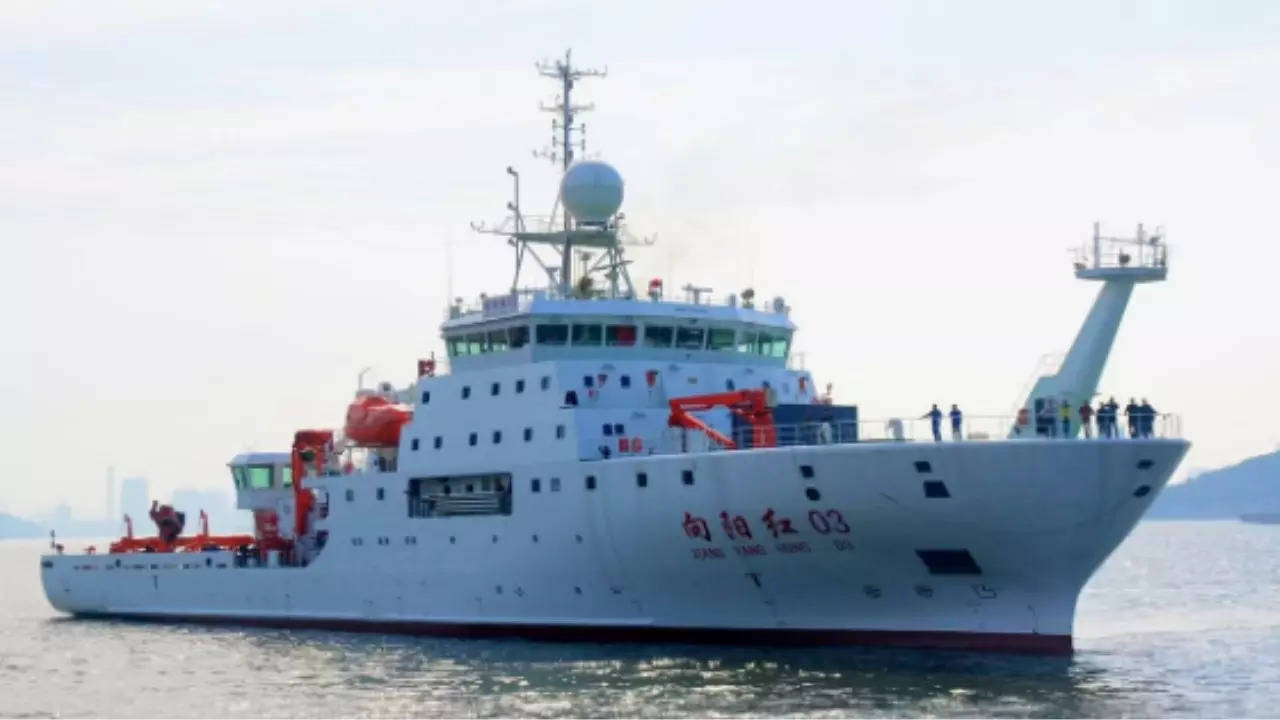[ad_1]
NEW DELHI: India is closely tracking another Chinese survey and research vessel, equipped with advanced surveillance equipment, now on its way to Malé amid the nose-dive in bilateral relations with the Maldives after the Beijing-leaning Mohamed Muizzu was elected the President in the archipelago in November.
Chinese research vessel Xiang Yang Hong 03 entered the Indian Ocean Region (IOR) through the Sunda Strait of Indonesia on Monday morning.“The vessel is expected to reach the Maldives by around the first week of February,” an Indian defence establishment official said.
The Chinese vessel is headed towards the Maldives after Sri Lanka refused permission for it to dock at one of its ports. “The Indian Navy is closely monitoring its movements,” the official said.
The Navy usually keeps track of such Chinese vessels using its fleet of P-8I long-range maritime patrol aircraft and warships as well as two unarmed MQ-9B Sea Guardian drones leased from the US for top-notch ISR (intelligence, surveillance and reconnaissance) missions in the IOR. Some of these assets, of course, are now deployed on the western seaboard to keep track of the escalating piracy and drone attacks in the Gulf of Aden and the Arabian Sea.
India has repeatedly conveyed to Sri Lanka its strong objections about such “dual-use” Chinese ships being allowed to dock at its ports and map oceanographic and other data useful for navigation and submarine operations in the IOR.
Chinese survey vessel Shi Yan-6 had docked at Colombo last October despite concerns raised by India. Earlier, in August, Chinese warship Hai Yang 24 Hao, with a crew of around 140, had also visited the port.
The docking of Chinese research and space-tracking vessel Yuan Wang-5 at Hambantota, in fact, had led to a major diplomatic spat between India and Sri Lanka in August 2022.
Such Chinese vessels, packed with large antennae, advanced sensors and electronic equipment, undertake snooping, monitor satellite launches and track trajectories of ballistic missiles test-fired by India in the IOR.
With Muizzu choosing to first visit China instead of India earlier this month, and inking a whole host of bilateral agreements in Beijing to strengthen their bilateral strategic partnership, India will now have to tackle the Maldives on this front as well.
In keeping with his “India Out” election campaign, Muizzu has already set a March 15 deadline for New Delhi to remove its over 70 military personnel who operate two naval advanced light helicopters, an offshore patrol vessel and a Dornier-228 maritime patrol aircraft in the archipelago.
With the world’s largest Navy with over 360 warships and submarines, China now maintains “a sustained presence” in the IOR with six to eight warships deployed at any given time, apart from research or spy vessels and many fishing vessels. Beijing is also working to establish logistical bases from the African east coast to the Malacca Strait, having already secured a few since establishing its first overseas base at Djibouti on the Horn of Africa in August 2017.
Chinese research vessel Xiang Yang Hong 03 entered the Indian Ocean Region (IOR) through the Sunda Strait of Indonesia on Monday morning.“The vessel is expected to reach the Maldives by around the first week of February,” an Indian defence establishment official said.
The Chinese vessel is headed towards the Maldives after Sri Lanka refused permission for it to dock at one of its ports. “The Indian Navy is closely monitoring its movements,” the official said.
The Navy usually keeps track of such Chinese vessels using its fleet of P-8I long-range maritime patrol aircraft and warships as well as two unarmed MQ-9B Sea Guardian drones leased from the US for top-notch ISR (intelligence, surveillance and reconnaissance) missions in the IOR. Some of these assets, of course, are now deployed on the western seaboard to keep track of the escalating piracy and drone attacks in the Gulf of Aden and the Arabian Sea.
India has repeatedly conveyed to Sri Lanka its strong objections about such “dual-use” Chinese ships being allowed to dock at its ports and map oceanographic and other data useful for navigation and submarine operations in the IOR.
Chinese survey vessel Shi Yan-6 had docked at Colombo last October despite concerns raised by India. Earlier, in August, Chinese warship Hai Yang 24 Hao, with a crew of around 140, had also visited the port.
The docking of Chinese research and space-tracking vessel Yuan Wang-5 at Hambantota, in fact, had led to a major diplomatic spat between India and Sri Lanka in August 2022.
Such Chinese vessels, packed with large antennae, advanced sensors and electronic equipment, undertake snooping, monitor satellite launches and track trajectories of ballistic missiles test-fired by India in the IOR.
With Muizzu choosing to first visit China instead of India earlier this month, and inking a whole host of bilateral agreements in Beijing to strengthen their bilateral strategic partnership, India will now have to tackle the Maldives on this front as well.
In keeping with his “India Out” election campaign, Muizzu has already set a March 15 deadline for New Delhi to remove its over 70 military personnel who operate two naval advanced light helicopters, an offshore patrol vessel and a Dornier-228 maritime patrol aircraft in the archipelago.
With the world’s largest Navy with over 360 warships and submarines, China now maintains “a sustained presence” in the IOR with six to eight warships deployed at any given time, apart from research or spy vessels and many fishing vessels. Beijing is also working to establish logistical bases from the African east coast to the Malacca Strait, having already secured a few since establishing its first overseas base at Djibouti on the Horn of Africa in August 2017.
[ad_2]
Source link


